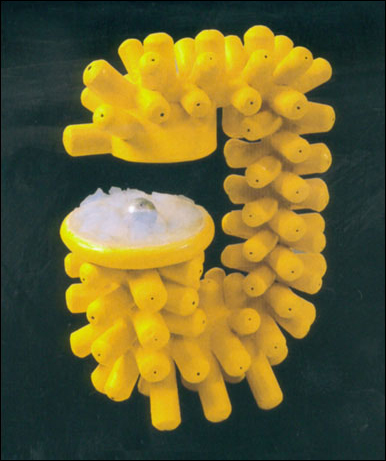The Protean Forms of John Newman
Upon viewing John Newman’s recent sculpture, one is struck by the lavish, unlikely combinations of material, color, and form. Bulbous shapes attenuate into lines, opaque bronze dissolves to glass, wicker constructions support arches of plaster, and hard metal gives way to crenelated velvet. Soft modeled forms describe serpentine flourishes in space and aggressive shafts penetrate planes. Often the work includes both highly abstract elements and others that allude directly to things of this world. Within most pieces, the theme of metamorphosis is explored with wit and ingenuity.

Some sculpture appears to be inspired by undersea life or microscopic phenomena one might observe in a petri dish. Homespun (splash) has gently undulating blue fins that surround a pinstriped white exoskeleton. This shell divides into two parts which together describe mirroring shapes not unlike meerschaum pipes. Out of both bowls of these pipes foray ungainly, wrinkled forms, which unite to close a circle in space. The seemingly soft tissue is misleading, however, as it forms a beak which penetrates an arched sheet of metal, leaving a distinct burr where the beak emerges on the other side.
Homespun (Gujarati collection) plays on architectural symmetry and the theme of transformation. Two series of extruded white tubes describe three roman arches. One series of arches is inverted, with another right side up, resting atop it. The plane defined by the series of arches recedes inward to create yet another arch. Between the columns are four hourglass-like forms in different materials. The first is like a bronze egg coddler, united at the center by a slender stem, while the second consists of two blown glass bubbles, one above the other, which seem to have been ever so slightly deformed by the weight they are baring. The third makes use of two elegant gourds or seeds and the last involves two intricately woven wicker basket forms. Elements of this sculpture were fabricated by Indian craftsmen, and as its title suggests, Homespun (Gujarati collection) has an affinity with Indian devotional sculpture and architecture. The meandering white arch has a phallic sensuality not unlike a lingam and domes inherent in Newman’s hourglass reflect the shape of a Buddhist stupa.
The fulcrum of Homespun (with a blue bubble) is a hand-blown bubble of blue glass, which due to technical imperfections of the craft, has subtle coloristic gradations. The bubble rests between two arched, volumetric forms resembling claws which are tied together with sisal at the center of the bubble. The pincer-like volumes of blue and white could be a shell that has grown to accommodate the needs of some prodigious mollusk. Between its jaws, opposing the bubble, is a web-like, linear construction. Like the other works, Homespun (with a blue bubble) characterizes form in evolution, which could undergo yet another sea change into something both familiar and unknown.
© Daniel Rothbart, 2000.